In performance testing process, we checked
out the speed of the LGA1155 platform with different low-profile memory modules
from Crucial Ballistix, using dual-channel technology. Each was tested in two
modes: 1) Auto configuration (every timing parameter was set by the BIOS of the
mainboard via XMP data) and 2) high clock rate and the best timing (as what has
been achieved in the overclocking tests above) were manually set up on the
mainboard’s BIOS.
First, we would like to check the
benchmarks of memory’s bandwidth and latency. We used two devices in order to
carry out that process. One is for testing the SiSoft Sandra 2013 memory. The
use of a Multithreaded Stream algorithm made it perfectly suitable for modern
memory controllers which were optimized for multi-core CPUs.
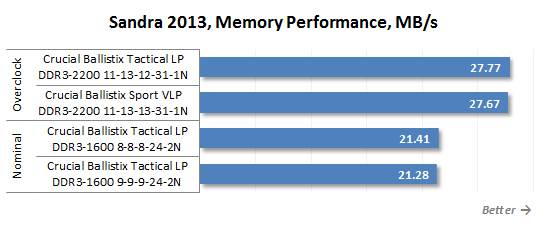
Performance
before and after overclocking
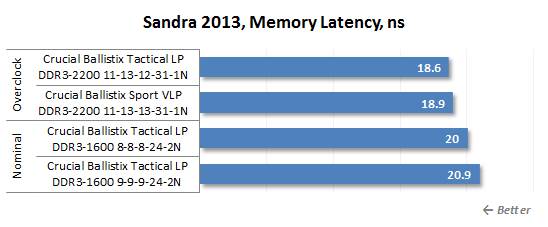
Latency
before and after overclocking
Another testing device is for checking the
compatibility via the ASUS MemTweaklt! Utility software, which would issue
single numbers indicating operating performances of the whole memory system.
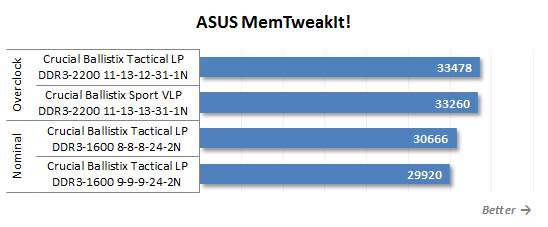
Performance
before and after overclocking
Ballistix Tactical LP and Ballistix Sport
VLP are comparable in both default configuration and overclocked configuration.
Almost as what we had expected because they had quite alike clock rate and were
distinguished by their timings. Memory timing does not affect much on the
operating performance of modern computer series. The overclocking process helps
improving the bandwidth and latency of the memory notably - up to 30%.
The results from SiSoft Sandra 2013 and
ASUS MemTweacklt! software suggest that these results make the practical
meaning more specific in DDR3 SDRAM selection. However, they are synthetic
benchmarks, whose meanings are to measure speed of CPU when working with system
memory. If these applications are conducted every day, they will turn out to be
meaningless. However, we still want to carry them out.
A fast memory is really appropriate in some
situations, especially when you can achieve a high speed easily with products
from Crucial Ballistix. The memory subsystem parameters can affect on gaming
applications.
Of course, Graphics subsystems definitely
influence the most on the frame rate, but the operating frequency of the memory
is the key element. A fast memory can help you improve the performance by a few
percent. Therefore, again, the choice of DDR3 SDRAM is very important,
especially when considering based on its operating frequencies.
We usually suggest the use of DDR3-1866 as
the optimum choice for current computer generations. The price of these kinds
of product is usually equal to its lower-speed counterparts and thus highlights
the best competitive price and operating performance characteristics.
Notwithstanding, DDR3-1600 SDRAM just like Ballistix Tactical LP and Ballistix
Sport VLP of Crucial creates an exception because, as we conducted our tests in
order to make sure, it can be easily overclocked to make a remarkable increase
(up to 10%) comparing to the nominal operating performance.
Power consumption
Beside the low profile, Ballistix series
from Crucial that we are testing today also satisfy the standards of DDR3L and
are able to work at the reduced voltage of 1.35 V. The reduction of voltage
also means the decrease in power consumption. Such memories are especially
suitable for mobile devices and servers. However, since Crucial introduced the
DDR3L SDRA to technology enthusiasts, we have recognized the benefits from
which computer users can earn.
First of all, you should be aware that
DDR3L must compact with the mainboard in order for the memory to be able to
work at the voltage of 1.35 V.
Almost every mainboard of the top brands
supports DIMM voltage under 1.5 V. However, you may want to ensure that your
mainboard allows setting the 1.3 V as the memory voltage in its BIOS. Our AUS
P8Z77-V-Deluxe not only supports DDR3L but also DDR3U, allowing us to choose
any voltage level from 1.2 V and 0.005 V each increase steps.
Thus, we can check how much power that our
computer consumes if it has used DDR3-1600 when working at the default voltage
or 1.35 V or at the overclocked mode with the voltage of 1.65 V. We used
Crucial Ballistix Tactical LP DDR3-1600 2x8GB (BLT2K8G3D1608ET3LX0) for this
testing process.
Corsair AX760i software provides the
support for managing the level or power consumption and thus we can use it for
our tests. In the following diagram, the full picture about the power (without
the monitor) is shown as measured at the PSU’s output. That is the sum of each
power consuming component while PSU’s performance is not taken into account.
The computer is using LinX0.6.4 64 bit with the assistance of AVX using the
whole capacity of the system memory. In order to have a more exact result for
the power consumption test in idle mode, we allowed all following saving
technology: C1E, C6, Enhanced Intel SpeedStep.
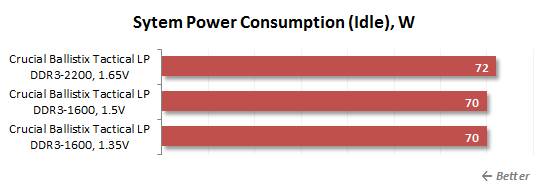
Power
consumption level in idle mode
When the computer is in idle mode, DDR3L
does not have any strength comparing to other normal system memory. DDR3L SDRAM
products do not produce much effect on the power consumption level of the whole
system. Therefore, changing the voltage from 1.35 to 1.5 V does not also create
any clear effect. However, overclocking process does influence on the level of
power consumption. Working at the speed of 2200 MHz and 1.65 V, the memory
increases the power of the computer up to 2W. On the other hand, the problem is
not the memory type but whether the CPU supports the DDR3 SDRAM controller is
the reason for more power consuming, because it must work with a high clock
rate memory.

The
power consumption in available mode
When the computer works with high load, this
picture does not change much. The power saving characteristics of the memory
does not affect the power consuming process of the whole system, especially
when the overclocking process is conducted inside. Compared to the ordinary
DDR3, DDR3L can save averagely 2W. Overclocking system memory just increases
overall power draw 1.5%. Therefore, it is very hard for the voltage in
low-profile Crucial Ballistix memories to become the outstanding advantage, at
least if we are talking about computers which are overclocked in a specific way
with Ivy Bridge processor and dual-channel memory: DDR3L in this case can also
save the same power draw with the ordinary DDR3 SDRAM.
Conclusion
We were not excited when Crucial brought us
a test about two new memory products which were Ballistix Tactical and
Ballistix Sport. How could DDR3, although targeted at technology fans, surprise
us? But it turned out that Crucial has introduced us interestingly original
products although there is no guarantee in the official specifications and
timings.
The main priority is the memory capacity,
version 16GB DDR-1600 SDRAM from Crucial Ballistix Tactical LP and Crucial
Ballistix Sport VLP, including low-profile models with shorter height than the
original model, offers us the compatibility with any DIMM slot and its
heatsinks will not block any heat pipes of the cooler, although it can mess up
the design of the cooler maybe.
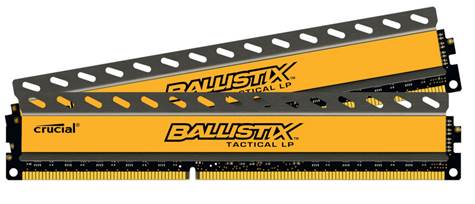
Crucial
Ballistix Tactical LP
The second advantage is that they always
meet the standards of DDR3L and are able to work at the voltage of 1.35 V. As
we have shown, it does not mean much in terms of saving, just one or two watts,
but this ensures a high frequency potential. When you can increase their
voltages, these memories can be overclocked to DDR3-2200 mode, which is an
achievement. Since Crucial Ballistix Tactical LP and Crucial Ballistix Sport
VLP were not more expensive than DDR3-1600 products, they finally attract many
consumers.
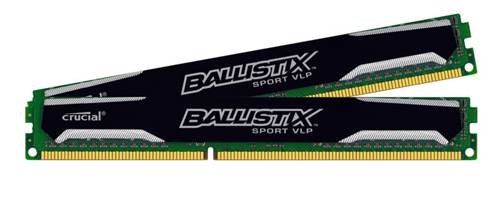
Crucial
Ballistix Sport VLP
It is up to you to decide which type of
memory module is better. Ballistix Tactical LP has eye-catching heatsink while
Ballistix Sport VLP size is smaller.